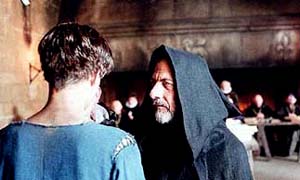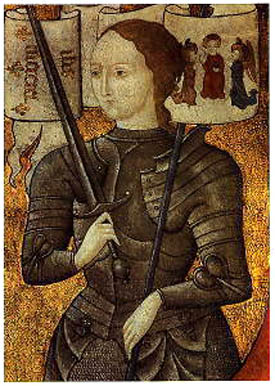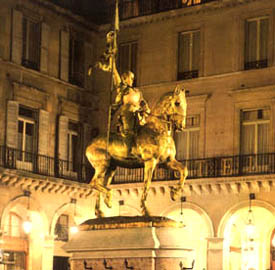 |
Movie Reviews
A Distorted View of the Maid of Orleans
The Messenger reviewed by Marian T. Horvat, Ph.D.
Some friends were concerned about both the dogma and history in the new movie by French director Luc Besson titled The Messenger: The Story of St. Joan of Arc. They asked my opinion. I had already heard about the “new look” of the Maid of Orleans whose providential vocation and extraordinary role in history I admire so much. I am not fond of the movie theater, but I made an effort to see this film to offer a Catholic commentary for my friends and perhaps others who might be interested in a not-so-conventional review.

A strange Joan of Arc fraught with
emotions and delusions |
Certainly the movie is beautifully filmed with remarkable acoustical effects that engulfed me from all sides. We have moved beyond the age of the mere image to the era where entertainment titillates and stimulates all the senses – while often ignoring the intelligence. When I was young, I remember dressing up to go to downtown Kansas City to the Grand Theater with its balconies and velvet seats. There was an air of grandeur, charm and romance. The screen was small, the acoustics poor, but there was an aristocratic air and sense of aesthetics that made movie-going an “going-out” kind of affair.
Sadly, all that prestigious cultural apparatus was missing in the short-ceiling, box-like room I ushered myself into. I seated myself among a small group dressed in the androgynous casual clothing that daily seems to become more normal. I was the misfit for having dressed up to go to the theater! How far the cultural revolution of ‘60s has permeated the tendencies of modern man reveals itself in simple events like going to a movie.
As for the film itself, some of the scenes are very poetic. For example, the scene that presents Joan of Arc charging forward on a magnificent white horse and carrying her delicate banner that waves with an epic air in the wind. After the end of the main battle at Orleans, the director has the good idea of taking a close-up of the English Fortress of the Augustines that appears over a river covered with a misty fog. Such scenes symbolically evoke the memory of other more glorious Christian times. The vivid and realistic battle scenes give a vivid impression of the very hard times imposed by the Hundred Years’ War (1337-1453) to which St. Joan of Arc was called in 1429 to bring the beginning of the end by rallying the French to an unexpected victory.
The victory of France against the coalition of the English and Burgundians played a providential role in the History of the Church. By preserving the independence of France, the Maid of Orleans preserved its Catholicism, which a century later England would reject. Who can guess the setback to Christendom if an English-controlled France had suffered this fate? The mission of St. Joan of Arc should be considered above all from this supernatural point of view. But in this as in all else, The Messenger lacked absolutely all sense of the supernatural.
An occultic “Christ”
As a Catholic I was extremely shocked by the two main messages the director transmitted in his rendition of the epic history. The first is a new-age and occultish presentation of Our Lord Jesus Christ. The figure of Our Lord Jesus Christ is presented in the early scenes as a young boy with the appearance of child Druid seated on a stone throne, emanating a disagreeable occultist aura. The second figure portraying Our Lord was perhaps even more repulsive: a vitiated hippie with deep bags under his eyes (Dustin Hoffman) giving the impression of a close familiarity with drugs. In an erotic wild circle dance, this figure twirls with Joan entwined around him. A grave desacralization of Christ and St. Joan.
Later, the same “Christ” appears again to Joan in the middle of a battle, and blood begins to pour down his despairing face in revolting profusion. “Joan, what are you doing to Me?” says a voice that recriminates the glory of her mission. These shocking and blasphemous portrayals of Our Lord, in my opinion, reveal a conception of the Savior far from Catholic and closer to some occult or spiritist interpretation.

A pacifist christ figure acts as a voice of conscience |
The final portrait of this evolving “Christ” completes the cycle as an aged, new-age pacifist god clothed in a miserablist brown cloak. His voice of “reason” finally convinces Joan that her mission is a delusion inspired by her desire for revenge and her own self-love. This god provokes her private admission of guilt, a denial of her mission as a messenger sent by God to save France. It is this that finally earns her absolution and the right to die a martyr. But this, let it be said clearly, is an outright lie. “Until the last,” said Mention, the recorder at the trial of Joan d’Arc, “she declared that her voices came from God and had not deceived her.”
This reconstructed history of the life of the Maid of Domremy not only lacks objectivity, but also goes against sound historical records and all Catholic tradition.
A deranged Joan
The second message the film sends is a disturbing distortion of the messenger herself. History teaches us that the real Joan of Arc was a sane, strong and solid peasant girl. The soldiers who followed her were won over by her compelling earnestness and faith. In her answers at the trial staged by the English, her simplicity, piety and good sense appear at every turn. Twenty-four years later, at a revision of her trial, all the witnesses were eager to render their tribute to the virtues and supernatural gifts of the Maid.

The Maid of Orleans, sane and pious |
Now this conflicts violently with the Joan of Arc played by Milla Jovovich in The Messenger. Here, Joan is more a scrupulous psychopath in an advanced stage of sickness than the angelic Pucelle de Lorraine. She nervously – sometimes hysterically – barks out short commands and orders. Her acts are sporadic and spastic, devoid of all charm and natural grace. At times, she even screams uncontrollably.
Once again, this seems a consequence of the occultist mysticism that underpins the whole picture. Every time that Joan of Arc has some “revelation,” a certain horrific and wild “air” with a background of eerie new-age music surrounds her, leaving the spectator apprehensive that something terrible is about to happen or appear. It is like the atmosphere in horror films when the directors wants to present devils, ghosts or other evil figures. The identity of the mysterious “voices” who counsel the saint are never revealed, suggesting that they are the result of some personal demon or delusion. But, in fact, history tells us that Joan herself clearly stated at the end of her trial that they were the voices of St. Michael, St. Catherine and St. Margaret (1). These saint names are never mentioned in The Messenger.
1. Joan of Arc: Self-Portrait, compiled. by William Trask, NY: Collier Books, 1961, pp. 96-7.
In all this, it is very obvious that the film director lacks the sensus catolicus, that he has no idea of the ways of God in making His revelations – very majestic but always paternal and gracious. One of the signs of the spirit of God, says the great Abbot Marmion, O.S.B., is that it always fills us with “peace and joy in believing” (2).
2. Union with God, compiled by Dom Raymond Thibaut, St. Louis: B. Herder Book Co., 1957, p. 4.
A numerous committee of learned bishops and doctors at Poitiers made a thorough three-week examination of Joan at Poitiers before Charles would put troops under her command. They found in the claims of the Maid of Orleans the supernatural guidance of the spirit of God, and they counseled Charles to accept her service.
The Joan portrayed in the film exudes a constant nervousness and overwhelming insecurity. She is devoid of the spirit of true union with the Divine Will, which is a spirit of peace and serenity. Moviegoers who do not know the true character of this epic figure whom the Church canonized in 1920 will be left questioning both Joan’s sanctity and sanity.
Outrageous historic falsehoods
But there are even more reasons to boycott this irreligious film. As a historian, I cannot avoid pointing out that the actress did not portray the glorious reality of the life of St. Joan of Arc. From the beginning, there are very serious distortions of the history we know. For example, the supposed attack of the English on the village of Domremy at the beginning of the film never occurred. Thus there was no rape of Joan’s sister, presented in the film with a raffinement of cruelty, including the macabre way the rape was consummated in an act with a corpse. This absolutely false scene sprinkles a touch of Freudian, or even satanic, pepper into the golden history of St. Joan of Arc. It also provides the motive of vengeance that can later “explain” her single-minded intent to rid the French countryside of the English “goddams.”
This sexual obsession appears again in an insinuated rape of the Maid herself in the English prison at Rouen castle during her trial in 1431. This scene is strongly offensive against the sacred memory of the Virgin of Domremy. The testimony of the Maid herself, recorded in the official records of her trial for heresy, offers clear proof that Our Lord protected the chastity of the Maid of France to the very end. The prison clerics recorded these words spoken by St. Joan in the early morning of the day of her execution: “Alas! Am I so horribly and cruelly treated, that my clean body, never yet defiled, must this day be burnt and turned to ashes!” (3)
3. Joan of Arc: Self Portrait, p. 125.
Another misrepresentation of the supernatural. At the beginning of the film, Joan appears at the court in Chinon in order to convince the Dauphin of the holy mission she had received from her voices. After miraculously identifying the sovereign, she offers him proof of her divine mission in a private interview. In the film, Charles VII is convinced only by her confused and breathless recounting of the visions, without any other evidence. Hardly a performance to convince a weak-kneed Dauphin to put an army at an uneducated girl’s disposal to raise the siege of Orleans.
We know the real history because at her trial, St. Joan of Arc revealed the sign. She said that an angel appeared “to my king, bringing him the crown, and telling him that he would possess the whole Kingdom of France, entirely, by God’s help and through my effort, and that he should set me to work — that is, give me soldiers — or he would nowhere near so soon be crowned and anointed” (4).
4. Ibid., p. 104.
Another blatant inaccuracy. Bishop Pierre Cauchon, the judge at the trial, is presented as complacent and compassionate toward Joan. In fact, this wretched Bishop of Beauvais was the worst of the servile churchmen bent on the Maid’s destruction and conviction. By serving the English party, he hoped to obtain the bishopric of Rouen. The most vital evidence of all is Joan’s own expostulation against a trial before Cauchon, who was her declared and bitter enemy.
Lies and blasphemies

A statue of Joan of Arc on the Place des Pyramides |
If I were to continue with the historical misrepresentations and falsifications of the facts, this review would grow to unpublishable lengths. However, one serious untruth still needs to be pointed out. Nowhere in the trial records is there the disavowal of the Holy Catholic Church that Joan makes at the end of The Messenger when she says that the Church that does not believe in her voices in not the true Church.
This new Joan — now with Protestant tinges — has two main errors that would never permit her to be raised to the altar as a saint. She revolts against the Church’s authority, and she places her personal “experience” of Jesus above the interpretation of the Magisterium.
In conclusion, The Messenger is a historical lie and a blasphemous presentation of one of the most charming and heroic Saints of the Church. Let me make a small homage to the Deliverer of France with this interesting story: When the virginal body of the Maid of France was completely burned, her heart was found intact among the ashes. Her enemies, witnessing this miraculous action of God, did not convert. On the contrary, they took the heart and threw it with her ashes into the Seine River. Some of the faithful witnessed this second sacrilege.
There is a longstanding tradition that says that when the heart of La Pucelle de Lorraine will be found, this will be the sign of the return of France to the Catholic Faith.

|
Movie Reviews | Home | Books | CDs | Search | Contact Us

© 2002- Tradition in Action, Inc. All Rights Reserved
|
 |
|